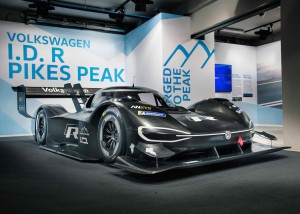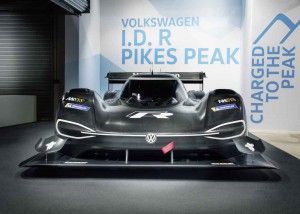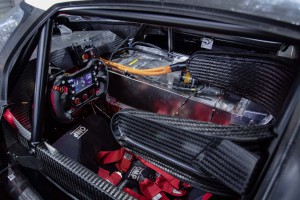
The Volkswagen I.D. R Pikes Peak is ready to make an attempt to break the EV speed record for the Pikes Peak race in June.
Volkswagen has been pushing to be seen as a leader, maybe THE leader, in the electric car arena and its newest introduction, the I.D. R Pikes Peak, may help cement that position.
The company’s first fully electric supercar was unveiled in Alès, France, and will compete in the Pikes Peak International Hill climb in Colorado Springs, Colorado, on June 24, with only one goal: beating the existing electric car record of 8:57.118 minutes in the annual “Race to the Clouds.”
This battery-electric supercar certain has the specs to make one thing that the record is in jeopardy. I.D. R Pikes Peak weighs less than 2,500 lbs and produces 680 horsepower and 479 lb-ft of torque, giving it a 0-60 mph time of 2.25 seconds, which is faster than Formula 1 and Formula E cars.
“Volkswagen’s goal is to reach the pinnacle of electromobility with the I.D. family,” said Dr. Frank Welsch, Volkswagen Member of the Board of Management with responsibility for Development.
(Big changes coming at VW says new CEO. Click Here for the story.)

The I.D. R Pikes Peak races from 0-60 mph in 2.5 seconds, which is faster than Formula One or Formula E cars.
“The hill climb on Pikes Peak will definitely be a real acid test for the electric drive. Customers have always benefitted from the findings made in motorsport, and we expect to take these findings and use them as a valuable impetus for the development of future I.D. models.”
The Race to the Clouds may be the ultimate test for an electric vehicle. Not only is the race is itself dangerous, involving a 4,720 vertical-foot climb and 156 corners with no barriers between the vehicles and the side of the mountain, but also drivers get just one single attempt.
Not only must the technology and driver be on top form as they attempt to set a new record, but also the external conditions must be perfect. It is not unheard of for finish-line temperatures at the 14,115-foot summit of Pikes Peak to be below freezing at the end of June.
The team is conducting its first round of mountain testing in Ales, France, to prep the car and its driver, defending Pikes Peak champion Romain Dumas, for the event. He’s definitely qualified to make the run at the record. The 39-year-old Frenchman has three victories at Pikes Peak, and also won the 24 Hours of Le Mans twice.

Engineers on the I.D. R Pikes Peak are looking more for balance between energy storage and battery weight than pure power.
(Click Here for more details about Diess taking over at VW.)
During this testing, VW engineers will find out it their plans to skip maximum performance for finding a balance between energy capacity and weight is the right approach. VW has run the race before with other vehicles.
The twin-engine Golf ran in 1985, 1986 and 1987 and in those races the engineers opted for a solution with two power units. The I.D. R Pikes Peak features two electric engines, generating a system capacity of 680 hp.
Lithium-ion batteries are used as the energy storage system, similar to production EVs, as their power density is the crucial factor for the system when producing high voltage. Roughly 20 percent of the electric energy required is generated during the drive, so the key here is energy recovery. When braking, the electric engines act as generators, converting some of the braking energy into electricity and feeding this into the battery.
The prototype for Pikes Peak justifiably bears two quality seals in its name, VW claims as the “R” is synonymous with performance cars, and the “I.D.” is the symbol of Volkswagen’s smart E-technology.
(A VW pickup? Click Here to see what might be in store for the Atlas Tanoak concept.)
The I.D. family of vehicles is leading VW’s revolution out of gas and diesel vehicles and into battery electrics. The company expects to have more than 20 EVs on the road by 2025 as part of the I.D. technology push.
